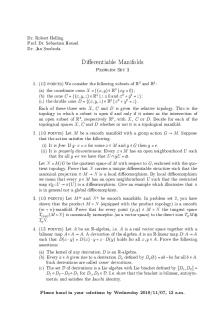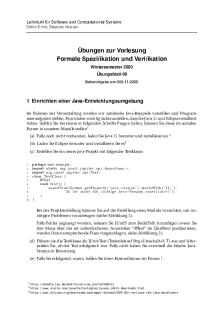Blatt 03 - ex3 PDF

| Title | Blatt 03 - ex3 |
|---|---|
| Course | Fixed Income Markets [MA3703] |
| Institution | Technische Universität München |
| Pages | 2 |
| File Size | 56.9 KB |
| File Type | |
| Total Downloads | 71 |
| Total Views | 146 |
Summary
ex3...
Description
Technische Universit¨ at M¨ unchen Lehrstuhl f¨ ur Finanzmathematik Prof. Dr. Rudi Zagst PD Dr. Aleksey Min
Winter term 2019/2020 Sheet 3 Discussion in the week November 26, 2019
Fixed Income Markets Exercise Sheet 3 Exercise 3.1 ˜ (t) be a one dimensional Wiener process under the measure Q. ˜ Solve the stochastic Let W differential equation ˜ (t), dr (t) = [θ − ar (t)]dt + σdW
by considering d(eat r(t)). Note that the quantity eat is called the integration factor.
Exercise 3.2 Using the results of Exercise 3.1 show that the short rate in the Vasicek model (see Page ˜ and 67 of the lecture slides or Exercise 3.4) under the equivalent martingale measure Q given Ft0 is normally distributed with expectation and variance given by θ E[r(t)|Ft0 ] = 1 − e−a(t−t0 ) + r(t0 )e−a(t−t0 ) ; a σ2 1 − e−2a(t−t0 ) . V ar[r(t)|Ft0 ] = 2a Exercise 3.3 In the Cox-Ingersoll-Ross model the short rate r(t) is modeled by p dr (t) = [θ − ar (t)]dt + σ r(t)dW˜ (t),
˜ (t) is the Wiener process under the equivalent martingale measure Q. ˜ where W Show that the short rate r(t) in the Cox-Ingersoll-Ross model under the equivalent ˜ and given Ft0 has expectation and variance given by martingale measure Q θ 1 − e−a(t−t0 ) + r(t0 )e−a(t−t0 ) ; E[r(t)|Ft0 ] = a σ2 r(t0 ) e−a(t−t0 ) − e−2a(t−t0 ) V ar[r(t)|Ft0 ] = a θσ 2 1 − 2e−a(t−t0 ) + e−2a(t−t0 ) . + 2 2a Hint: To compute the mean, first determine r(t) by using the method of Exercise 3.1. Note that the expectation of any Itˆo integral is equal to zero. To compute the variance, first determine r 2 (t) by considering d(e2atr 2 (t)). Then compute E[r 2 (t)|Ft0 ] by interchanging expectation and integration and using the computed expectation E[r(t)|Ft0 ]. Please turn the sheet 1
Exercise 3.4 In the Vasicek model the short rate r(t) is modeled by ˜ (t), dr (t) = [θ − ar (t)]dt + σdW ˜ (t) is the Wiener process under the equivalent martingale measure Q. ˜ where W Show that the Vasicek model is a short-rate model with affine term structure and ˜ and B from Definition 4.2 (s. Page 69 of the the corresponding deterministic function A ∗ lecture slides) for all t0 ≤ t ≤ T ≤ T are given by 2 2 2 ˜ T ) = [B(t, T ) − (T − t)](θa − 0.5σ ) − σ B (t, T ) ; A(t, 4a a2 −a(T −t) 1−e B(t, T ) = . a
Exercise 3.5(∗) In the Cox-Ingersoll-Ross model the short rate r(t) is modeled by p dr (t) = [θ − ar (t)]dt + σ r(t)dW˜ (t),
˜ (t) is the Wiener process under the equivalent martingale measure Q. ˜ where W Show that the Cox-Ingersoll-Ross model is a short-rate model with affine term structure and the corresponding deterministic function A˜ and B from Definition 4.2 (s. Page 69 of the lecture slides) for all t0 ≤ t ≤ T ≤ T ∗ are given by 2ce0.5(a+c)(T −t) 2θ ˜ ; A(t, T ) = 2 ln (a + c)(ec(T −t) − 1) + 2c σ √ 2[ec(T −t) − 1] B(t, T ) = , where c = a2 + 2σ 2 . (a + c)(ec(T −t) − 1) + 2c (∗)
May be time consuming and will be shown in the exercises. Hint: To compute B(t, T ), you have to solve the Riccati differential equation.
2...
Similar Free PDFs

Blatt 03 - ex3
- 2 Pages

Blatt 03 loesung
- 14 Pages

Diffgeo 1 blatt 03
- 1 Pages

Blatt 03 - WS 2018/2019
- 2 Pages

Blatt 03 - Übung und Lösung
- 5 Pages

Top ex3
- 1 Pages

Ex3 - venturi meter
- 4 Pages

Blatt 4
- 2 Pages

Blatt 06
- 2 Pages

Blatt 01
- 3 Pages

Blatt 01
- 2 Pages

Blatt 2
- 2 Pages

Blatt 05
- 4 Pages

Blatt 01
- 2 Pages

Blatt 00
- 2 Pages

Blatt 01
- 5 Pages
Popular Institutions
- Tinajero National High School - Annex
- Politeknik Caltex Riau
- Yokohama City University
- SGT University
- University of Al-Qadisiyah
- Divine Word College of Vigan
- Techniek College Rotterdam
- Universidade de Santiago
- Universiti Teknologi MARA Cawangan Johor Kampus Pasir Gudang
- Poltekkes Kemenkes Yogyakarta
- Baguio City National High School
- Colegio san marcos
- preparatoria uno
- Centro de Bachillerato Tecnológico Industrial y de Servicios No. 107
- Dalian Maritime University
- Quang Trung Secondary School
- Colegio Tecnológico en Informática
- Corporación Regional de Educación Superior
- Grupo CEDVA
- Dar Al Uloom University
- Centro de Estudios Preuniversitarios de la Universidad Nacional de Ingeniería
- 上智大学
- Aakash International School, Nuna Majara
- San Felipe Neri Catholic School
- Kang Chiao International School - New Taipei City
- Misamis Occidental National High School
- Institución Educativa Escuela Normal Juan Ladrilleros
- Kolehiyo ng Pantukan
- Batanes State College
- Instituto Continental
- Sekolah Menengah Kejuruan Kesehatan Kaltara (Tarakan)
- Colegio de La Inmaculada Concepcion - Cebu